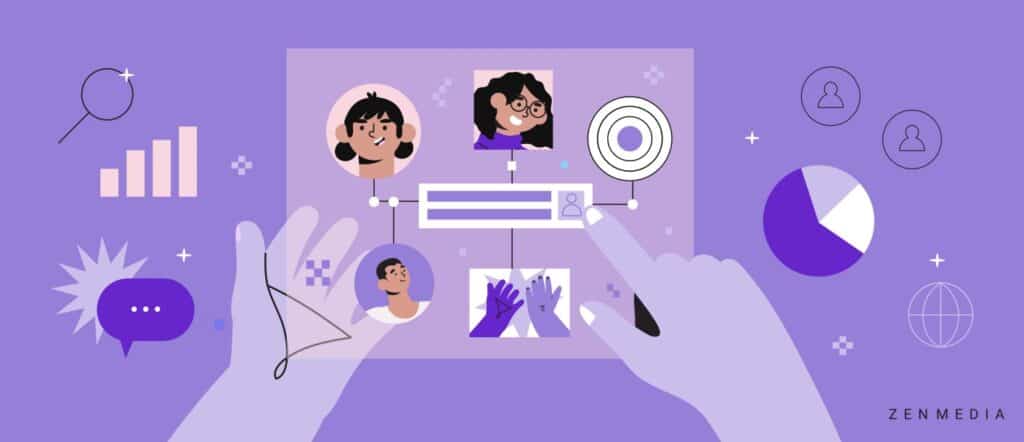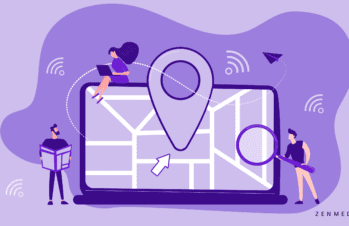To truly succeed in the digital age, B2B brands must meet consumers where they are, and that place is undoubtedly social media.
By harnessing the potential of platforms like Facebook, Twitter, LinkedIn, Instagram, and more, businesses can actively engage with their audience, forge meaningful connections, and stay at the forefront of industry trends. A solid B2B social media marketing strategy is no longer an afterthought; it has become a mandatory component for B2B companies aiming to amplify their reach, establish thought leadership, and drive meaningful business outcomes.
Tools and Tactics
Social media gains new users yearly, so businesses must adjust their strategies to meet them where they frequent. The ever-expanding user base on various social media platforms presents a vast opportunity for B2B companies to tap into a growing pool of potential customers and partners. It’s not just about having a presence on social media; it’s about actively engaging with the users and providing value through meaningful interactions.
In today’s digital landscape, businesses have a plethora of tools at their disposal to streamline their social media marketing strategies and achieve their goals painlessly and promptly. These tools can help in various aspects of the marketing process, from content creation and scheduling to analytics and performance tracking. By leveraging the right set of tools, B2B brands can optimize their digital marketing campaigns, enhance their reach, and ultimately drive conversions—all while minimizing costs.
When considering the vast array of social media marketing tools available, it’s important to understand that each product offers unique features and functionalities. Comparing these tools can provide valuable insights into which ones align best with your specific needs and objectives. Whether you require a robust content management system, an analytics platform for in-depth performance tracking, or a social listening tool to monitor conversations around your brand, carefully assessing and comparing products can help you make informed decisions for your next campaign.
And even when you’ve integrated the right tools into your process, you’ll need to identify the most effective marketing tactics for reaching your audience. One thing is certain, though, neglecting your social presence is never a good idea.
Even if you don’t have a huge marketing budget, there are numerous social media tactics that can help you gain exposure, attract new audiences, and promote your brand—all without requiring a substantial financial investment.
Social media offers an (almost) level playing field, allowing businesses of all sizes to compete for attention and engagement. Whether you’re a startup, a small business, or an established enterprise, an effective social marketing strategy can help you amplify your brand presence, build credibility, and foster meaningful connections with your target audience.
From optimizing your profiles to reflect your brand identity and values to creating compelling and shareable content, each action you take on social media has the potential to attract attention, spark conversations, and generate interest in your products or services. Engaging with your audience through comments, messages, and discussions allows you to build relationships and establish yourself as a trusted industry authority.
Related Reading: Ultimate Guide to B2B Social Media Marketing
LinkedIn: Where B2Bs Thrive
Gone are the days when LinkedIn was merely seen as an online resume platform. It has evolved into a robust social media platform, empowering B2B companies to expand their network, foster thought leadership, and stay on top of industry trends. Whether you are a small startup, a mid-sized firm, or a multinational corporation, understanding and harnessing the power of LinkedIn can be a game-changer for your B2B marketing strategy.
LinkedIn offers a unique ecosystem that aligns perfectly with these objectives. It provides a fertile ground for businesses to connect with like-minded professionals, showcase their expertise, and generate high-quality leads.
Hack the LinkedIn Algorithm
We’ve heard a lot about hacking the Facebook algorithm and hacking the TikTok algorithm, but LinkedIn is the place to be for professionals and businesses, so here are our top four tips for hacking the LinkedIn algorithm:
- Optimize Post Time: Timing is crucial when it comes to capturing your audience’s attention on LinkedIn. To increase the likelihood of your posts being seen, aim to publish them between 9 a.m. and 5 p.m. on weekdays. This aligns with peak business hours when professionals are actively browsing the platform, increasing the chances of your content appearing in their feeds.
- Prioritize User Engagement: Engagement plays a pivotal role in LinkedIn’s algorithm. To please the algorithm and enhance the visibility of your posts, focus on generating meaningful interactions. Aim for at least 20 or more engagements per post, including likes, comments, and shares. Encourage conversation, ask questions, and provide valuable insights to prompt engagement from your audience. Engaging with comments on your post is equally important, as it signals to the algorithm that your content is generating conversation and value.
- Keep it on-platform: LinkedIn prefers to keep its users engaged within its own ecosystem. Therefore, when creating content, do your best to avoid linking out to external websites. LinkedIn’s algorithm tends to favor native content, which is published directly on the platform. Utilize LinkedIn’s publishing tools, such as native articles, videos, and images, as they are more likely to reach a larger audience and garner higher engagement rates.
- Take Advantage of New Features: LinkedIn constantly introduces new features and updates to enhance the user experience. Be open-minded and adapt to these changes as they occur. Embracing new features, such as LinkedIn Live, Stories, or Polls, can give your content a competitive edge and help you stand out in the crowd. Stay informed about LinkedIn’s latest developments and explore how these features can be integrated into your content strategy.
Remember, the LinkedIn algorithm is not set in stone, and it is subject to change. Stay agile, monitor the performance of your posts, and adapt your approach accordingly. By implementing these optimization tactics and staying attuned to LinkedIn’s evolving landscape, you can position your content for success and maximize your visibility and engagement on the professional network.
Build a Network on LinkedIn
LinkedIn is a goldmine of opportunities to connect with potential customers, business partners, industry leaders, and influencers. To build an effective network on LinkedIn, you’ll need to do two things to start:
- Identify potential customers and business partners: LinkedIn provides a powerful search function that allows you to identify and connect with individuals who align with your target audience or business goals. Start by defining your ideal customer profile or the types of businesses you want to partner with.
- Search for relevant industry leaders and influencers: LinkedIn is brimming with industry leaders and influencers who can inspire, educate, and provide valuable insights. Building connections with these individuals can help you stay informed about the latest trends, gain industry knowledge, and expand your professional network. Start by identifying key thought leaders in your industry by searching for specific keywords or hashtags relevant to your field.
Engage with their content by liking, commenting, and sharing posts. This not only helps you establish a presence within their community but also opens the door for meaningful conversations and potential collaborations. When reaching out to industry leaders or influencers, be genuine and specific about why you value their expertise and how you believe a connection can be mutually beneficial.
Networking on LinkedIn is not just about collecting connections; it’s about nurturing relationships and fostering meaningful interactions. Take the time to engage with your network by sharing relevant content, participating in group discussions, and providing value through your expertise. Building a strong network on LinkedIn requires consistent effort and a genuine interest in connecting with others.
Get the Most Out of LinkedIn Groups
Think you are using LinkedIn to its full potential? If your spokespeople and thought leaders, including C-suite executives and subject-matter experts, aren’t actively engaging in LinkedIn groups, then you likely aren’t.
LinkedIn groups provide a valuable opportunity to connect with like-minded professionals, share insights, and establish your brand’s thought leadership. To get the most out of LinkedIn groups, try this:
- Find the right groups to join: The first step is to identify and join relevant LinkedIn groups that align with your industry, target audience, or areas of expertise. Start by searching for industry-specific groups, professional communities, or groups associated with specific topics or interests related to your business. Evaluate the group’s size, activity level, and engagement to ensure it aligns with your goals. Look for groups with a diverse membership that includes industry leaders, potential customers, and peers who can contribute to valuable discussions.
- Join the right conversations: Once you’ve joined relevant LinkedIn groups, it’s time to actively participate in conversations. Start by listening and observing to understand the group dynamics and topics of interest. Engage with existing conversations by providing thoughtful comments, sharing insights, and offering valuable resources. Demonstrate your expertise by providing practical advice, answering questions, and sharing relevant experiences. By contributing valuable insights, you can establish yourself as a trusted authority and build connections with fellow group members.
- Start the right conversations: Don’t limit yourself to only participating in existing discussions. Take the initiative to start your own conversations and spark meaningful discussions within the group. Identify relevant topics, pose thought-provoking questions, or share industry news or trends that can generate interest and engagement. Encourage group members to share their perspectives, experiences, and expertise. By initiating conversations, you can position yourself as a thought leader and create opportunities to showcase your brand’s unique value proposition.
Remember, the key to leveraging LinkedIn groups effectively is not just about self-promotion but about building relationships, providing value, and fostering meaningful connections. Engage in discussions with an authentic and helpful mindset, demonstrating your willingness to contribute to the community. Consistency is vital, so allocate dedicated time to participate actively in group conversations and regularly share valuable content.
Facebook: The OG Social Network
Now with nearly three billion users, Facebook has established itself as a powerhouse platform with a massive user base and robust advertising capabilities. Clearly, the original social network still carries some clout (and marketing usefulness).
Facebook offers an array of powerful tools and features that B2Bs can leverage to drive growth, expand their reach, and establish themselves as industry leaders. By employing advanced targeting options, creating engaging marketing content, building communities, retargeting leads, and leveraging Messenger for customer support, B2Bs can be confident in their Facebook marketing strategies.
Paid Ads on Facebook
Facebook’s advertising platform provides B2Bs with unparalleled targeting options. The granular targeting capabilities allow businesses to precisely reach their ideal B2B audience based on factors such as industry, job title, company size, interests, and more. By leveraging this wealth of data, B2Bs can ensure that their content and paid ads are served to decision-makers and key influencers within their target industries, maximizing the effectiveness of their campaigns and driving quality leads.
Building a Community with Groups
Much like LinkedIn Groups, Facebook Groups present a unique opportunity for B2Bs to foster a sense of community among their target audience. By creating and managing a dedicated group related to their industry or niche, B2Bs can facilitate discussions, share insights, address pain points, and establish themselves as a go-to resource for industry professionals. By actively engaging in group conversations, answering questions, and providing valuable content, B2Bs can cultivate a loyal following, generate leads, and even uncover collaboration opportunities with other businesses in the ecosystem.
Related Reading: The Facebook Algorithm Explained
Instagram: The Visual Network
With its visually-driven nature and engaged user base, Instagram offers a fertile ground for B2Bs to showcase their brand, connect with their target audience, and drive meaningful engagement. It is also the perfect place to curate user-generated content (UGC).
UGC is a powerful asset that can help B2Bs build trust, social proof, and authenticity. By actively encouraging customers, clients, and industry partners to create and share content featuring their products or services, B2Bs can tap into their community’s genuine enthusiasm and experiences.
By encouraging customers or clients to share images or videos of their experiences, B2Bs can highlight how their offerings solve specific problems or deliver exceptional results. This user-generated visual content serves as powerful social proof and can influence potential customers considering similar solutions. Sharing these real-world applications builds credibility and inspires confidence in the effectiveness and relevance of the B2B’s offerings.
To maximize the impact of UGC, B2Bs should actively engage with and amplify user-generated content. By reposting UGC on their Instagram feed or stories, B2Bs demonstrate their appreciation for their customers while also providing them with a sense of recognition and validation. This engagement not only strengthens the relationship with existing customers but also encourages others to contribute their own UGC. B2Bs can also use Instagram’s tagging and mention features to ensure proper attribution to the original creators, further fostering a sense of community and collaboration.
Leveraging Influencers and Brand Advocates
Instagram is full of influencers. While B2Bs tend to find some of their best partners on LinkedIn, there’s a great opportunity for visual-centric brands to partner with influencers on Instagram. Partnering with influencers who have a strong presence in the B2B space can help B2Bs reach a wider audience and enhance their credibility.
B2Bs in the technology and software sectors can leverage B2B influencer marketing and find valuable partnerships by collaborating with industry experts, tech bloggers, or content creators specializing in visually appealing tech-related content. These influencers can demonstrate the B2B’s products or services, provide tutorials, and share their experiences with the offerings.
By providing influencers with access to their products or services and encouraging them to share their experiences, B2Bs can tap into the influencer’s engaged following and leverage their UGC to drive brand awareness and generate leads within the target market.
Threads: Organic content to rival Twitter
While maintaining its spot as the visual platform, Instagram is treading into new waters with Threads—their copy-based platform. While Threads is still relatively new, here is what we know thus far:
Threads is a writing-focused platform that is all about authenticity and building connections. Right now, this platform is really aimed at individuals (not companies), but it is still a tool B2Bs can definitely leverage. How? Thought leadership. Talk to your CEO or spokesperson about using Threads to build thought leadership and cultivate a following.
Tip: Don’t just post your own threads, comment on others. Because there is no search feature (no hashtags or search bar) the best way to expand your reach and gain followers is by commenting on threads relevant to your area of expertise.
Twitter: It’s Still Kickin’
While we aren’t sure about the future of Twitter with the recent launch of Meta’s Threads app, we know a lot has changed since the app’s launch in 2006. In fact, our founder and CEO, Shama Hyder, wrote her master’s thesis on Twitter as she was one of the first users.
Threads is comparable to Twitter, and though we have yet to see its full set of features and the implications for what it means for B2B marketers, it is likely that some of the same “rules” will apply.
At least, we hope so. Because Twitter provides an ideal platform for B2Bs to position themselves as thought leaders in their industry. By sharing valuable insights, industry trends, and timely news, B2Bs can showcase their expertise and knowledge.
Consistently posting informative and engaging content can attract followers and build credibility, encouraging others to look to the B2B (or business leader) as a reliable source of industry information.
TikTok: The Gen Z Hero
When we wrote about TikTok when it first launched, it had about 100 million active U.S. users. Now it boasts over 150 million active U.S. users and more than a billion users worldwide—with an expectation to near 2 billion by the end of 2023.
Although it may seem like the platform for young people, brands are finding great success on TikTok.
TikTok provides a unique opportunity for B2Bs to showcase their company culture and give audiences a behind-the-scenes look into their operations. By creating engaging and authentic content, businesses can humanize their brand and establish a sense of trust and transparency. From showcasing team activities and events to highlighting employee achievements, TikTok allows B2Bs to connect on a personal level with their target audience, attracting potential customers and even potential employees.
Plus, the short-form video format encourages businesses to distill complex ideas into concise and engaging content. Business leaders and brands can share industry insights, tips, and tutorials related to their niche. By positioning themselves as thought leaders and sharing valuable knowledge, B2Bs can attract a following of professionals who are interested in their expertise.
And we couldn’t talk about TikTok without mentioning the viral trends. 2Bs can leverage these trends by participating in relevant challenges or creating their own that align with their brand message. By injecting creativity and humor into their content, B2Bs can increase brand visibility, engage with their audience, and differentiate themselves from competitors.
So if you had to pick one social media network to represent your brand on, what would it be?
And if you want to know which social media you should be on, reach out. We’d love to help with your social media marketing strategy.





